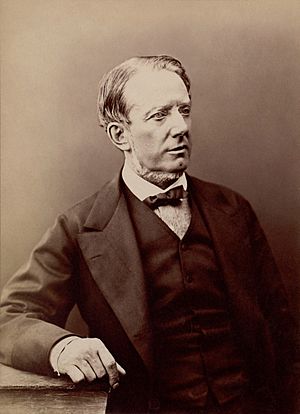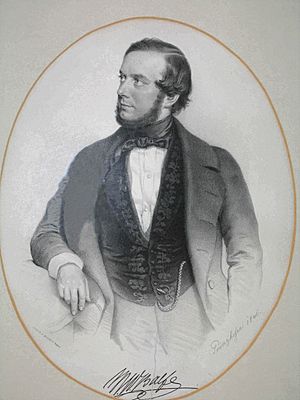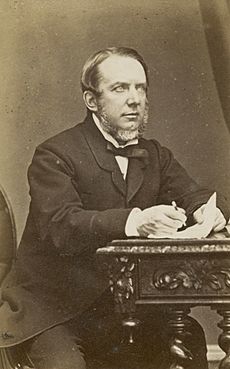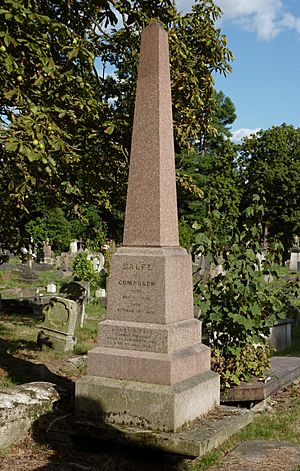Michael William Balfe facts for kids
Michael William Balfe (born May 15, 1808 – died October 20, 1870) was a famous Irish composer. He is most known for his operas, especially one called The Bohemian Girl.
Balfe started as a violinist, but he soon became an opera singer. While singing, he also began to write music. Over 40 years, he wrote at least 29 operas, nearly 250 songs, and many other musical pieces. He was also a talented conductor, leading Italian Opera at Her Majesty's Theatre for seven years.
Contents
The Life of Michael Balfe
Early Musical Journey
Michael Balfe was born in Dublin, Ireland. His musical talent showed up very early. His father, who was a dancing teacher and violinist, taught him music. He also learned from the composer William Rooke. When he was a child, his family moved to Wexford.
Between 1814 and 1815, Balfe played the violin for his father's dance classes. At just seven years old, he wrote a polacca, which is a type of dance music. In 1817, he played the violin in public for the first time. That same year, he wrote a ballad (a slow song) called "Young Fanny."
In 1823, after his father passed away, teenage Balfe moved to London. He got a job playing violin in the orchestra at the Theatre Royal, Drury Lane. He later became the leader of this orchestra. While there, he studied violin with Charles Edward Horn and learned how to compose music with Charles Frederick Horn.
Singing and Composing in Europe
While still playing the violin, Balfe also wanted to be an opera singer. He tried singing in an opera in Norwich but it wasn't very successful. In 1825, a rich supporter named Count Mazzara took him to Rome, Italy. There, Balfe studied singing and music. He also met famous musicians like Luigi Cherubini.
Balfe started composing more seriously. In Italy, he wrote his first big stage work, a ballet called La Perouse. He became a student of the famous composer Rossini. In 1827, Balfe sang the role of Figaro in Rossini's opera The Barber of Seville in Paris.
Balfe then returned to Italy and stayed there for eight years. He continued to sing and write several operas. In 1829, he wrote his first cantata (a piece for singers and instruments) for the young singer Giulia Grisi. This piece was very popular. Balfe's first full opera, I rivali di se stessi, was performed in Palermo in 1829–1830.
Around 1831, in Switzerland, he married Lina Roser, a singer from Hungary. They had two sons and two daughters. Balfe wrote more operas, including Un avvertimento ai gelosi and Enrico Quarto. In 1834, he sang in Rossini's Otello at La Scala in Milan.
Finding Success as a Composer
Balfe came back to London with his family in May 1835. His first big success happened a few months later. His opera The Siege of Rochelle opened on October 29, 1835, at Drury Lane. This success encouraged him to write more operas in English, like The Maid of Artois in 1836.
In July 1838, Balfe wrote a new opera called Falstaff. It was based on the play The Merry Wives of Windsor and had an Italian script. Famous singers like Luigi Lablache and Giulia Grisi starred in it.
In 1841, Balfe tried to start a National Opera company at the Lyceum Theatre, but it didn't work out. That same year, his opera Keolanthe premiered. He then moved to Paris and presented more operas, including Le Puits d'amour (1843) and Les quatre fils Aymon (1844).
Meanwhile, in 1843, Balfe returned to London. There, he created his most famous work, The Bohemian Girl. It opened on November 27, 1843, at the Theatre Royal, Drury Lane. The show ran for over 100 nights! Soon, it was performed in New York, Dublin, Vienna, and all over Europe. Later, it was adapted into Italian and French versions, which were also very popular.
Later Life and Legacy
From 1846 to 1852, Balfe became the main music director and conductor for the Italian Opera at Her Majesty's Theatre. He introduced many of Verdi's operas to London audiences. He also conducted for the famous singer Jenny Lind when she made her opera debut.
In 1851, Balfe wrote a special cantata called Inno Delle Nazioni for the Great International Exhibition in London. Nine female singers, each representing a different country, sang it. Balfe kept writing new operas in English, such as The Armourer of Nantes (1863). He also wrote hundreds of songs, including "I Dreamt I Dwelt in Marble Halls" (from The Bohemian Girl), "Come into the Garden, Maud", and "Killarney." His last opera, The Knight of the Leopard, was almost finished when he died. It was very successful in Italian as Il Talismano.
Balfe retired in 1864 and moved to a country estate in Hertfordshire. He passed away at his home in Rowney Abbey, Ware, Hertfordshire, in 1870, at age 62. He was buried at Kensal Green Cemetery in London. In 1882, a special portrait of him was placed in Westminster Abbey. A plaque in London also remembers him at 12 Seymour Street, Marylebone.
In total, Michael Balfe wrote at least 29 operas. He also composed several cantatas and one symphony. Today, his opera The Bohemian Girl is the most well-known of his works and is still performed.
Selected Operas by Balfe
Here are some of Michael Balfe's operas and when they were first performed:
- I rivali di se stessi (Palermo, 1829)
- The Siege of Rochelle (London, 1835)
- The Maid of Artois (London, 1836)
- Falstaff (London, 1838)
- Le Puits d'amour (Paris, 1843)
- The Bohemian Girl (London, 1843) - His most famous work!
- Les Quatre fils Aymon (Paris, 1844)
- The Daughter of St. Mark (London, 1844)
- L'étoile de Seville (Paris, 1845)
- The Rose of Castille (London, 1857)
- Satanella, or The Power of Love (London, 1858)
- The Armourer of Nantes (London, 1863)
- Il talismano (London, 1874 – performed after his death)





